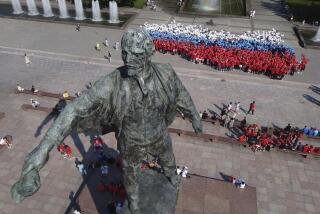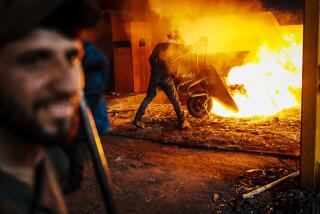Soviet Quandary
- Share via
The impression is growing among Russia-watchers in the West that Soviet leader Mikhail S. Gorbachev really does want to withdraw Soviet troops from Afghanistan--but only on his own terms. Until the Kremlin is willing to risk a return to non-Communist rule after Soviet troops leave, the war will go on.
When Soviet forces moved into Afghanistan in late 1979 to install a puppet regime of Moscow’s choosing, the Kremlin clearly did not expect such fierce resistance. Despite combat support from 115,000 Soviet troops, the Communist government in Kabul still does not exercise real control over more than a fifth of the country. The Soviets have suffered an estimated 30,000 casualties, including perhaps 12,000 dead. Now that the guerrillas are armed with U.S.-made Sting anti-aircraft missiles, the Soviet and Afghan government forces are said to be losing an average of one aircraft per day.
The fanatically Muslim, Pakistan-based guerrillas can’t drive the Soviets out. But neither can the Soviets crush the resistance.
The Soviets could probably tolerate the present level of casualties indefinitely. They are probably more concerned by the political cost. The war is a major irritant in Soviet relations with Iran and the Arab countries, and is a potential source of trouble with the Soviet Union’s own large Muslim population. The Soviet occupation of Afghanistan is a major obstacle to the Kremlin’s efforts to improve relations with China. And the exposure of Soviet soldiers to easily available drugs in Afghanistan is creating a serious drug problem at home.
In recent months the Soviets have made some concessions. Within the framework of U.N.-sponsored negotiations, they have agreed to accept international supervision of an ultimate Soviet troop withdrawal and the ending of U.S. and other outside aid to the guerrillas. Since the beginning of the year Mohammed Najibullah, head of the Soviet-installed Afghan government, has proposed a cease-fire, promised a coalition government that would include non-Communists and even pledged to declare Afghanistan a Muslim state.
The Soviets have publicly insisted on a four-year timetable for withdrawal, but are expected to offer a shorter schedule--and perhaps announce the unconditional withdrawal of a few thousand troops--when negotiations resume Feb. 11.
Neighboring Pakistan, uncomfortable with the presence of 3 million Afghan refugees and the danger of becoming a target of Soviet aggression, would like to see the war settled. The Reagan Administration is seemingly willing to accept a negotiated solution that would leave Afghanistan as an independent, basically nonaligned country.
Unfortunately, the Soviets and their puppets in Kabul take away with one hand what they appear to offer with the other. They want the guerrillas to lay down their arms before a Soviet withdrawal is complete. Comrade Najib, as Moscow’s hand-picked Afghan government leader likes to be called, has said plainly that the Communist Party would continue to call the shots in a coalition government. He also says that, even after a Soviet pullout, his regime would reserve the right to ask for the return of Soviet troops.
This double-talk reflects the quandary facing the Soviets. Moscow seemingly wants to withdraw its troops, but, with Soviet troops gone, the Afghan people would almost certainly throw out the Communists. And there is no sign that the Kremlin is ready to stomach the reversal of a “revolution” that it has declared irreversible.
What the Soviets really seem to be trying, at this point, is to lure Pakistan and the United States into pressuring the Afghan guerrillas to accept a political settlement that would leave them disarmed and too weak to resist the permanent Sovietization of Afghanistan. If this ploy doesn’t work, and it probably won’t, the Soviets will remain stuck with the war indefinitely until they are willing to accept a neutral but basically non-Communist Afghanistan.
More to Read
Sign up for Essential California
The most important California stories and recommendations in your inbox every morning.
You may occasionally receive promotional content from the Los Angeles Times.










